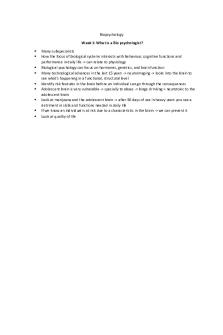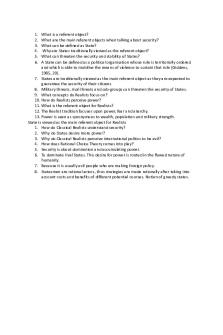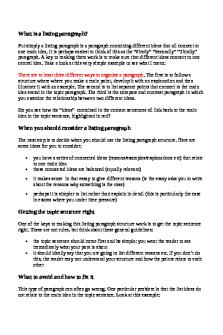What is a Breadth Indicator PDF

| Title | What is a Breadth Indicator |
|---|---|
| Author | georgia barber |
| Course | An introduction to business and management |
| Institution | The Open University |
| Pages | 4 |
| File Size | 44.2 KB |
| File Type | |
| Total Downloads | 9 |
| Total Views | 151 |
Summary
in depth notes on the topics discussed in the b100 module...
Description
What is a Breadth Indicator ?
A breadth indicator is a mathematical formula that measures the number of shares going up and down, and/or their volume, to calculate participation in the price movement of a stock index. By evaluating how many shares rising or falling prices, and how much of the traded volume, breadth indicators help in confirming the trend of stock index prices, or to warn a reversal of the price that will come.
KEY PICK UP
Breadth indicators usually do not give trading signals themselves, but gives an overall picture of the health of the index.
Usually, when the breadth indicator rises, and the stock index rises, this indicates a strong participation in price increases . This means that the increase in prices is more possible to maintain her own.
The same concept applies to falling broad indicators and falling stock index values. When broad indicators and stock indices diverge, it may warn of a reversal. More little stock that moves to the direction of the index stocks. This means that the stock index may be preparing to change direction.
Calculating the Breadth Indikator Indicator
There are a number of broad indicators, each with its own formula and calculation method . Some broad indicators are cumulative, with daily values added or subtracted from previous values. Others are non-cumulative, with each day or period providing its own data point .
One of the simplest breath indicators is the Forward/Reject Line. This is a cumulative indicator where an advance clean (the number of shares rose - the number of shares that declined) is added or subtracted from the value before.
What Extensive Indicators Tell You?
The breadth indicator gives traders and investors an overall view of the market . The stock "market" is usually checked using a stock index .
For example, Line Forward / Fall index S & P 500 is the cumulative guide to determine whether more many stocks go up or down over time. Calculations have showed sentiment of investors as a whole in all the stocks in the index.
The breadth indicator is mainly used for two purposes:
Market Sentiment: Broad indicators can help determine whether the market is more likely to go up or down.
Trend Strength : Broad indicators can help determine the strength of an up or down trend .
There are many different broad indicators that traders and investors can use in their analysis.
Some other popular broad indicators , apart from Forward/Down Lines , include:
On Balance Volume which focuses on the addition or reduction of volume based on whether a stock or index closed at the top or at the bottom of the price of closing earlier.
McClellan Sum Index
Arms Index (TRIN) which looks at the ratio of increases to declining stocks, divided by the ratio of increases to declining volumes .
Chaikin Oscillator that oscillates based on volume and price movements .
Volume Up/Down Ratio is the increase in stock volume divided by the decrease in stock volume .
Up/Down Volume Spread which is the up volume minus the down volume . There are many other broad indicators .
Traders and investors can use different broad indicators for different purposes . For example, On Balance Volume looks at buying and selling pressure from a volume perspective rather than looking purely at price, whereas the McClellan Sum Index involves a more complex formula that generates actual buy and sell signals
Some breadth indicators, such as the Chaikin Oscillator and On Balance Volume, can be applied to individual stocks or even other assets . Indicators spacious more
—such as Forward/Descent Lines or Weapon Index — calculated only by index.
Traders use market-wide indicators along with other forms of technical analysis , such as chart patterns and technical indicators, to maximize their chances of success. For example, if the Forward/Deceiving Lines start to fall while the S&P 500 is still rising, traders will be watching closely for the S&P 500 breaking below an ascending trend line , breaking below support, or technical indicators turning bearish. This will help ensure that the price may start to fall, and therefore traders can exit a buy position or initiate a sell position.
Examples of indicators breadth
The following chart shows two broad indicators , On Balance Volume and Force Index, on the chart of the SPDR S&P 500 ETF (SPY).
Picture
Image by Sabrina Jiang © Investopedia 2020
The Force Index (at the bottom) shows strong bearish sentiment in early February during the market downturn and relatively weak bullish sentiment throughout the period. On Balance Volume shows bullish volume during the February and March recovery and moderate volume in the following months. These indicators show that the market was relatively neutral between April and June.
Differences Between Indicators of Breadth and Indicators Technical
Broad indicators are a subset within the larger area of technical indicators. While broad indicators attempt to measure e participation and strength in the movement of stocks or indices, technical indicators have a much bigger purpose . Technical indicators can be used to analyze volume or price, generate trading signals , or determine support and resistance.
Limitations of Using Extensive Indicators
The breadth indicator will not always warn of a reversal. They also will not always confirm the price movement , even if the price continues to move in the same direction .
Most of the breadth indicators are susceptible to some situational anomalies. While traders usually look for volume to increase as price moves further, this is not always the case. The trend can last very long on a decrease in volume or even a decrease in share participation, which will cause the broad indicators to diverge but not necessarily result in a price reversal.
Certain area indicators may also produce odd readings due to their calculation method . On Balance Volume can be increased or decreased as significantly, for example, if there is a day of great volume but prices ended only slightly higher or lower. The price barely moves, but the indicators can move a lot ....
Similar Free PDFs

What is a Breadth Indicator
- 4 Pages

What is a Biopsychologist
- 1 Pages

What is a referent object
- 1 Pages

What is a social fact
- 2 Pages

What is ABA - Grade: A
- 5 Pages

What is race - Grade: A
- 1 Pages

What is a sectional title
- 4 Pages

What is a summary judgement
- 5 Pages

What is a product - lecture
- 4 Pages

What is a Digital Object?
- 17 Pages

What is a ketogenic diet
- 2 Pages

What is a listing paragraph
- 14 Pages
Popular Institutions
- Tinajero National High School - Annex
- Politeknik Caltex Riau
- Yokohama City University
- SGT University
- University of Al-Qadisiyah
- Divine Word College of Vigan
- Techniek College Rotterdam
- Universidade de Santiago
- Universiti Teknologi MARA Cawangan Johor Kampus Pasir Gudang
- Poltekkes Kemenkes Yogyakarta
- Baguio City National High School
- Colegio san marcos
- preparatoria uno
- Centro de Bachillerato Tecnológico Industrial y de Servicios No. 107
- Dalian Maritime University
- Quang Trung Secondary School
- Colegio Tecnológico en Informática
- Corporación Regional de Educación Superior
- Grupo CEDVA
- Dar Al Uloom University
- Centro de Estudios Preuniversitarios de la Universidad Nacional de Ingeniería
- 上智大学
- Aakash International School, Nuna Majara
- San Felipe Neri Catholic School
- Kang Chiao International School - New Taipei City
- Misamis Occidental National High School
- Institución Educativa Escuela Normal Juan Ladrilleros
- Kolehiyo ng Pantukan
- Batanes State College
- Instituto Continental
- Sekolah Menengah Kejuruan Kesehatan Kaltara (Tarakan)
- Colegio de La Inmaculada Concepcion - Cebu



